Hector Guimard
| Hector Guimard | |
|---|---|
|
Hector Guimard with his wife, Adeline Oppenheim Guimard | |
| Born |
10 March 1867 Lyon, France |
| Died |
20 May 1942 (aged 75) New York City, United States |
| Nationality | French |
| Occupation | Architect |
| Buildings |
|
Hector Guimard (10 March 1867 – 20 May 1942) was a French architect, who is now the best-known representative of the Art Nouveau style of the late nineteenth and early twentieth centuries.
Guimard's critical reputation has risen since the 1960s, as many art historians have praised his architectural and decorative work, the best of it done during a relatively brief fifteen years of prolific creative activity.
Early life
Guimard was born in Lyon. Like many other French nineteenth-century architects, he attended the École nationale supérieure des arts décoratifs in Paris from 1882 to 1885, where he became acquainted with the theories of Eugène Emmanuel Viollet-le-Duc. These rationalist ideas provided the basis for his idiosyncratic form of Art Nouveau. In 1884 he was awarded three bronze and two silver medals at the school for his work. In 1885 he received awards in all of the competitions at École nationale supérieure des arts décoratifs including four bronze medallions, five silver, and the school's Grande Prix d'Architecture.
In 1885 Guimard began his studies at the École Nationale et Speciale des Beaux-Arts in Paris, and he was admitted to the first year at École Nationale des Beaux-Arts in 1888. Later, in 1890, he was awarded a silver metal for "modelled ornament" at Ecole des Beaux-Arts.
In 1891 Guimard became an Assistant professor in descriptive geometry, shadow, and perspective drawings of the girls' section at the École des Arts Décoratifs in Paris. He was named a professor the following year in 1892 of the girls' section and was also named a professor of perspective in 1894. He remained there until 1900.
In 1893 he designed the lettering and street numbers for the Hotel Villa de la Réunion at 142 avenue de Versailles, Paris, which were produced for him by the ceramicist Emile Muller.[1] The following year Guimard visited the Hôtel Tassel in Brussels, designed by Victor Horta, and the latters works was to become a profound inspiration.
His first solo commission and breakthrough came in 1894, when he designed Castel Béranger at 14, rue La Fontaine, Paris, for Mme. Fournier. Carried out over four years, he persuaded his client to abandon a more restrained design and replace it with an overt embracement of the art of the curvilinear. In a single commission Guimard demonstrated how architecture and the industrial arts could be united in a single building to create a unified, modern scheme. See[2] and.[3]
A flashing glory
_Porte_Dauphine_Paris_16e_002.jpg)
The Castel Béranger made Guimard famous and he soon had many commissions. He continued to develop his own form of Art Nouveau, especially devoted to the ideal of harmony and continuity, which caused him to design the interior furnishings and decoration of his buildings as well. This approach culminated between 1909 and 1912 when he created his own home, Hotel Guimard[4] (his wedding present to his rich American wife) where ovoid rooms[5] contained unique pieces of furniture which are considered integral parts of the building.
If the skylights favored by Victor Horta are rather absent in his work (except in his 1910 Mezzara Hotel), Guimard made noteworthy experiments in space and volume. Some of these include the Coilliot House[6] and its disconcerting double-frontage (1898), La Bluette[7] and its beautiful volumetric harmony (1898), and especially the Castel Henriette[8] (1899) and the Castel d’Orgeval[9] (1905), radical demonstrations of a vigorous and asymmetrical "free plan", twenty-five years before the theories of Le Corbusier. But other buildings of his, like the splendid Nozal Hotel,[10] (1905), employ a rational, symmetrical, square-based style like that of Viollet-le-Duc.
Guimard also employed some structural innovations, as in the extraordinary concert hall Humbert-de-Romans[11] (1901), where a complex frame divided sound waves resulted in perfect acoustics (built 1898 and sadly demolished in 1905), or as in the Hôtel Guimard (1909), where the ground was too narrow to have the exterior walls bear any weight, and thus the arrangement of interior spaces differ from one floor to another.[12]
The curious, inventive Guimard was also a precursor of industrial standardization, insofar as he wished to diffuse the new art on a large scale. His greatest success here – in spite of some scandals – was his famous entrances to the Paris Metro,[13] based on the ornamented structures of Viollet-le-Duc. The idea is taken up – but with less success – in 1907 with a catalogue of cast iron elements applicable to buildings : Artistic Cast Iron, Guimard Style.[14]
Guimard's art objects have the same formal continuity as his buildings, harmoniously uniting practical function with linear design, as in the Vase des Binelles,[15] of 1903 or this sketch of his furniture.
His inimitable stylistic vocabulary suggests plants and organic matter, while remaining abstract. Flexible mouldings and a sense of movement are found in stone as well as wood carvings. Guimard created abstract two-dimensional patterns that were used for stained glass (Mezzara hotel, 1910), ceramic panels[16] (Coilliot House, 1898), wrought iron[17] (Castel Henriette, 1899), wallpaper[18] (Castel Béranger, 1898) or fabric[19] (Guimard hotel, 1909).
Oblivion
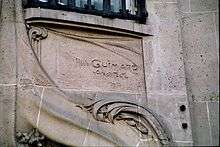
Despite Guimard's innovations and talent, the press grew tired of him—not so much with his work, but his personality. His relationship with the clergyman who commissioned him to build the Humbert de Romans Concert Hall (arguably the most complete expression of his Art Nouveau style) became acrimonious by the time of its completion in 1901, and the clergyman left France. Within five years the magnificent concert venue was demolished; it is now only known by photographs and articles from art journals. A large number of his Paris Métro station entrances, including all of the large pavilions such as the one at Bastille, were demolished. The only full, roofed enclosures left are the original one at Porte Dauphine and the reconstructed ones at Abbesses and Châtelet, although many of the fenced entrances remain or have been rebuilt. Guimard died, aged 75, in New York City, USA.
Guimard's work is itself victim of inherent contradictions of the ideals of the Art Nouveau style: his best creations remained unaffordable to the general public, and his attempts at standardization of materials, parts, and measures never could keep pace with his stylistic changes. Guimard's fear of war and the Nazi Party's anti-Semitism (his wife was Jewish) forced him into exile in 1938, and he was largely forgotten when he died in New York, at the Adams Hotel, 80th Street and Fifth Avenue on 20 May 1942. He is buried in Gate of Heaven Cemetery in the hamlet of Hawthorne, New York, about 25 miles north of New York City.
The rediscovery
Many of Guimard's buildings were destroyed after his death, but he started to be rediscovered during the 1960s. Now, scholars have reconstructed his career and he has been the subject of much research. Still, one hundred years after what Le Corbusier termed the "magnificent gesture" of Art Nouveau, most of Guimard's buildings remain inaccessible to the public, and he has no museum devoted to him. However, original architectural drawings by Guimard are stored in the Dept. of Drawings & Archives at Avery Architectural and Fine Arts Library at Columbia University in New York City.
Projects
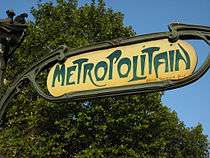 | |
|
|
- 1888 Café Au grand Neptune (quai d'Auteuil, 16th arrondissement de Paris).
- 1889 Pavilion of Electricity at the 1889 World's Fair in Paris.
- 1890 Construction of a small dwelling in Billancourt (Monsieur Lecolle, owner)
- 1891 Hôtel Roszé (rue Boileau, 16th arrondissement of Paris)
- 1894 Hôtel Jassedé (rue Chardon-Lagache), Hôtel Delfau (rue Molitor), and the funerary chapel of Devos-Logie and Mirand-Devos in the cimetière des Gonards at Versailles. Guimard first meets Belgian Art Nouveau architect Paul Hankar.
- 1895 Atelier Carpeaux (boulevard Exelmans, Paris), and the École du Sacré Cœur. First meets Belgian Art Nouveau architect Victor Horta. Beginning of construction on the Castel Béranger (rue La-Fontaine, Paris).
- 1896 La Hublotière au Vésinet.[20]
- 1897 Guimard moves into an apartment building. Coilliot House.
- 1898 Castel Béranger which is called "deranged" by contemporaries.
- 1899 Villa Bluette (Hermanville, Calvados).
- 1900 Coilliot House (14, rue Fleurus, Lille); design of the entrances, buildings and lettering of the stations entrance of the Paris Métropolitan (of 141 entrances created, 58 survive, including one moved to Montreal, plus four reproductions in Chicago, Lisbon, Mexico City, and Moscow)
- 1901 Salle Humbert-de-Romans (Paris); Castel Henriette (rue des Binelles, Sèvres, Hauts-de-Seine).
- 1903 Castel Val (4, rue des Meulières, Auvers-sur-Oise); Villa La Sapinière (Hermanville).
- 1904 Castel Orgeval (2 avenue de la Mare-Tambour, Villemoisson-sur-Orge); Hôtel Léon Nozal (16th arrondissement of Paris).
- 1905 Hôtel Deron Levet, Chalet Blanc (2, rue du Lycée, Sceaux).
- 1909 Immeuble Trémois, rue Agar; Guimard marries Adeline Oppenheim and they move into the Hôtel Guimard on a triangular lot on the Rue Mozart, Paris.
- 1910 Hôtel Mezzara (60, rue La Fontaine, 16th arrondissement de Paris)
- 1913 Synagogue de la rue Pavée à Paris (10, rue Pavée, in the 4th arrondissement de Paris); Villa Hemsy (3, rue Crillon, Saint-Cloud).
- 1924 Villa Flore (avenue Mozart, 16th arrondissement de Paris).
- 1926 Apartment building (rue Henri Heine, Paris).
- 1928 Apartment building (rue Greuze, Paris), this is widely believed to be Guimard's last work as an architect.
Gallery
- Coilliot House, Lille, 1900
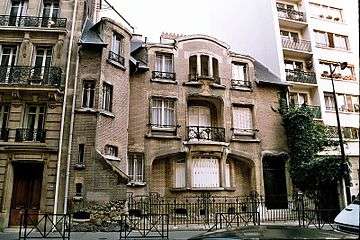 Hôtel Mezzara, 60 rue La Fontaine, Paris, 1910
Hôtel Mezzara, 60 rue La Fontaine, Paris, 1910 Synagogue de la rue Pavée, Paris, 1913
Synagogue de la rue Pavée, Paris, 1913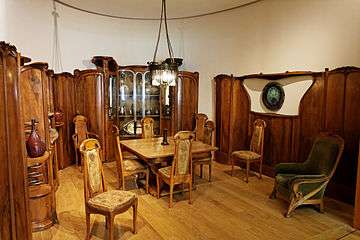 Dining room in l'hôtel Guimard
Dining room in l'hôtel Guimard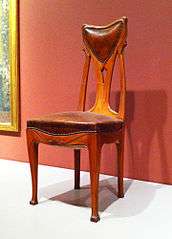 Side chair, 1900
Side chair, 1900
See also
- Paris architecture of the Belle Époque
- Concours de façades de la ville de Paris which he won in 1900
Notes
- ↑ Art Nouveau Furniture by Alistair Duncan, p.120 ISBN 0500233624
- ↑ 14 Castel Beranger Guimard, rubens.anu.edu.au
- ↑ Arch.mcgill.ca
- ↑ Hôtel Guimard d'Hector Guimard, lartnouveau.com
- ↑ Salle à manger, lartnouveau.com
- ↑ Maison Coilliot à Lille, lartnouveau.com
- ↑ La Villa La Bluette, lartnouveau.com
- ↑ Accueil, lecercleguimard.com
- ↑ Guimard (5t.jpg, aplressources.free.fr
- ↑ L'Hôtel Nozal d'Hector Guimard, lartnouveau.com
- ↑ Salle Humbert de Romans, lecercleguimard.com
- ↑ Lartnouveau.com
- ↑ "Parisinconnu.com". parisinconnu.com.
- ↑ Panneau central de grand balcon, insecula.com
- ↑ Vase des Binelles en grès - (Musée national Adrien Dubouché), musee-adriendubouche.fr
- ↑ , lartnouveau.com
- ↑ Stanries.com
- ↑ Guimard 5mi.jpg, aplressources.free.fr
- ↑ Hector Guimard: Panel | Work of Art | Timeline of Art History | The Metropolitan Museum of Art, metmuseum.org
- ↑ La hublotière - Hector Guimard - Redirect by ulimit.com, hublotiere.fr.st
External links
| Wikimedia Commons has media related to Hector Guimard. |
- Le Cercle Guimard
- lartnouveau.com - The work of Hector Guimard in Paris and in France
- art-nouveau-around-the-world.org Hector Guimard
- Guimard's works in the Cooper-Hewitt, National Design Museum
- Hector Guimard in American public collections, on the French Sculpture Census website

- Hector Guimard architectural drawings and papers, circa 1903-1933, (bulk circa 1903-1929) Held in the Dept. of Drawings & Archives, Avery Architectural & Fine Arts Library, Columbia University, New York City
